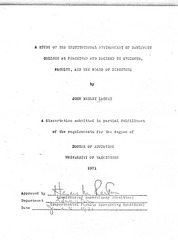A Study of the Institutional Environment of Northwest College as Perceived and Desired by Students, Faculty, and the Board of Directors
Description
Reproduction from microfilm. Missing Appendix C. The major purposes of this study were twofold: to develop an instrument for measuring the religious characteristic of the college environment andto study the institutional environment of Northwest College, Klrkland, Washington, both as it was perceived and desired by the students, faculty, and the board of directors. The analyses were conducted to see Ifdifferences in perceptions and desires existed—if the different groups described the environment similarly and how their desires for the institution were related to what they believed existed. A religion scale of thirty statements was developed which was then administered to five colleges—two public and three church sponsored—to further determine the validity of the items. This scale was then added to College and University Environment Scales (CUES) developed by C. Robert Pace. Two sets of responses—one for measurement of perceived environment measurements and one for measurement of desired environment measurements—were thensought from the students, faculty, and college board of directors. Means, standard deviations, mean differences, F ratios, and t values were computed. The findings revealed that there were differences between the students, faculty, and board of directors in perceptions of the environment. The board of directors indicated higher scale scores on practicality, awareness, scholarship, and religion. Analyses of student sub-group responses indicated some differences based on sex, residence, and college program.Scale scores on desired environment indicated student, faculty, and boarddifferences. Analyses of student sub-group responses indicated differences based on sex, college residence, attendance at other colleges, college program, and participation in extra-curricular activities. Analyses of perceived-desired responses revealed higher desired scale scores in the majority of the comparisons.
Original extent
x, 146 pages plus appendices
Collections
Copyright
This original work is protected by copyright. Copyright is retained by the author(s). Works may be viewed, downloaded, or printed, but not reproduced or distributed without author(s) permission.


 Maintained by the Northwest University Library
Maintained by the Northwest University Library